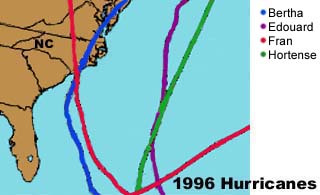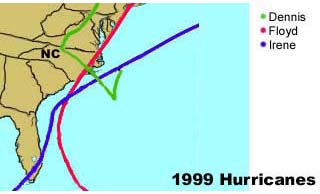A hurricane is a type of tropical cyclone that forms over warm tropical waters (80æF or higher) where the winds are light and the humidity is high. It begins as a tropical disturbance and can grow to become a hurricane as long as the above conditions are maintained.
Heavy thunderstorms and tremendously strong winds are generated from hurricanes. While hurricanes lose energy and fuel as they travel inland, they still bring torrential rains that lead to heavy flooding.
- 1996. Four
hurricanes passed through or within 210 km of North Carolina's coast.
- July 12-13. Hurricane Bertha
- August 31-September 1. Hurricane Edourdo
- September 5-6. Hurricane Fran
- September 13-14. Hurricane Hortense
- 1999. Three
hurricanes passed through NC, or near the coast.
- September 4-5. Hurricane Dennis
- September 16. Hurricane Floyd
- October 17. Hurricane Irene
(www.nhc.noaa.gov/pastall.shtml; Paerl et al, 2001; Etherington & Eggleston, 2000).
|
|
|
||||||||||||||||||||||||||||||||||||||||||||||||||||||||||||||||||
This table compares normal volume of freshwater inflow to Pamlico Sound with inflow during September and October, 1999. The three hurricanes in 1999 occured within a six-week time span. This caused heavy flooding throughout most of the eastern part of the state, and increased freshwater input into Pamlico Sound.
The river basins received more than half of their annual rainfall in just two months. The floodwaters that resulted displaced three-fourths of the volume of the Sound in just six weeks. Normal displacement time is approximately 11 months!
- How do you think this flooding of freshwater impacted the estuarine ecosystem, and the blue crab population in particular?
Table 2 compares the chemical and biological composition of the estuary's water during normal conditions with water composition between September and October 1999. The data shows that the chemistry of the water in the estuary was significantly altered during these six weeks.
- What effect would repeated hurricane and flooding events have on the water chemistry in the estuary?
- How do you think this change in water chemistry affected the inhabitants of the estuary, and the blue crab in particular?
|
|||||||||||||||||||||||||||

